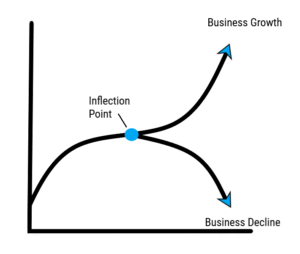Much of my coaching practice revolves around organizational change. Most team members can recognize organization-level challenges. Leaders are responsible for helping the organization adapt to face those challenges, so they ask the organization to change in some ways. Over the years, I’ve been able to study successful change initiatives. I’ve noticed that successful change initiatives are often associated with what I call strategic inflection points.
I’ll define that in a minute, but first, we need to look at 1) the challenge of a successful change initiatives and
2) how they interact with the organizational culture. In order to do so, we need a concise definition of culture.
What’s your company’s culture?
There are as many definitions of company culture as there are companies who talk about their culture. Here, I’ll define “culture” as the way things are done around here. It’s an effective, simple, and direct definition.
In this sense, culture occurs naturally. Your organization has a culture, whether you’ve thought about and cultivated it or not. It may not be a unified culture – marketing may not do things the same way production does. There is a (one or more) way things are done around here, and your people understand what it is.
As leaders, we would like for new initiatives, process improvements, policy, etc. to become habits for our people – to integrate these things into the way things are done around here.
We hope we are empowering our team to understand the reasoning behind the changes and make decisions in support of organizational goals. We want our people to build habits in these areas, so they react quickly and appropriately when presented with challenges. Also, as we grow, new team members learn these things more easily. Finally, the way things are done around here is a more effective training and disciplinary tool than having to distribute policy documents and police them. Peer-level discipline is more effective than policing, perhaps because it is continuous.
Why do we need change?
Our role as leaders is to notice areas needing improvement, and improvement always requires change. We’re typically impatient about change, in part because we see the benefits of change so clearly and because we are aware of so many needed changes. These factors often lead to a “management initiative of the month”. Your team may have successfully avoided change in the past, which gives them confidence to try to avoid this one as well. They may think, “this is just like the last time, if we’re patient it’ll go away and leadership will move on to some other initiative”.
A manager’s lack of understanding around the habitual nature of culture may cause change initiatives to fail. When we want to see change happen, we pretend that motivation is all our people need, then they will magically change on their own. So, we craft a motivational message and “rally the troops” around a new initiative. We use language to heighten the sense of urgency, hoping that this urgency will reinforce our peoples’ motivations to change.
However, motivation alone doesn’t usually work – just ask anyone who has ever tried to quit a smoking habit. Motivation and enthusiasm have a half-life, which can be pretty short. What else can leaders do? Play to the strength of habits.
Habits have a strong environmental component. It is often the environment providing the cue in the cue-response-reward cycle of habit formation. Therefore, one of the easiest ways to change a habit is to be faced with an environmental change. This change will weaken – or possibly eliminate – the environmental cues, thus weakening the old habit.
Environmental Changes
So, now we’re ready to think about strategic inflection points. Since environmental changes can disrupt existing habits, we can use them to our advantage. Given the habitual nature of culture, we can see how a company culture has momentum and is hard to change quickly. An environmental change weakens that momentum, making culture change easier.
If we can notice when the environment is changing and supply a new response and reward, we increase the likelihood of a new, more useful, habit being formed. Establishing new habits can change an organization’s culture step by step.
An environment change can be a useful trigger to inspire an organizational change.
This is why I refer to environmental change as one kind of strategic inflection point. Environmental changes are usually accompanied by organizational challenges in the sense that, if not handled correctly, they can damage the future of the organization. This risk leads leaders to see them as challenges, but we can also use them as opportunities. If we notice them early on and do a little planning, we can use them to our advantage.

Of course, there are different types of strategic inflection points, such as the exit of a key leader or moving office locations. Or Covid and working from home.
Regardless of the type, my advice is to use strategic inflection points as opportunities to improve upon your company culture. Many challenges and opportunities produce strategic inflection points, we just need to learn to recognize them and use them to help us improve our organizations.
So, as leaders, we are each facing a significant strategic inflection point – coming back to the office after a year of pandemic-induced working from home. I hope I’ve shown that this is a strategic inflection point and convinced you that it is a great opportunity for cultural change.
Over the next weeks and months, we will look at ideas for cultural changes (i.e. communications culture and meeting culture, among others). This strategic inflection point may be just the thing that provides you the opportunity to build new habits to support the culture you want for your organization.








